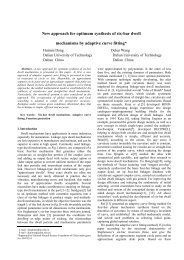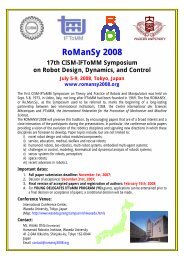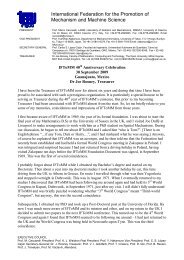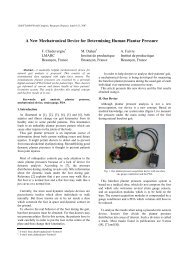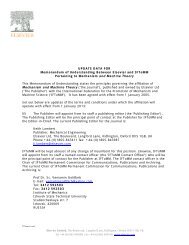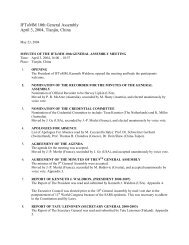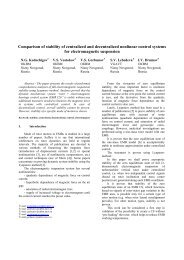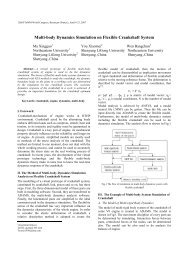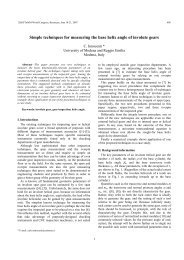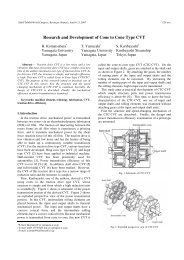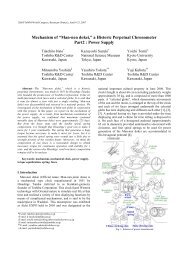Prof. Dr.Ing. habil. Willi Rehwald â 90 Years - IFToMM
Prof. Dr.Ing. habil. Willi Rehwald â 90 Years - IFToMM
Prof. Dr.Ing. habil. Willi Rehwald â 90 Years - IFToMM
You also want an ePaper? Increase the reach of your titles
YUMPU automatically turns print PDFs into web optimized ePapers that Google loves.
<strong>Prof</strong>. <strong>Dr</strong>.<strong>Ing</strong>. <strong>habil</strong>. <strong>Willi</strong> <strong>Rehwald</strong> – <strong>90</strong> <strong>Years</strong><br />
Laudatio<br />
<strong>Willi</strong> <strong>Rehwald</strong> was born on December 14, 1917 in the town Kroppenstedt in Sachsen<br />
Anhalt/Germany. He had his precollege schooling and Abitur in 1936 at Oberrealschule in the city of<br />
Egeln, and then was active as a practicant at the JunkersAircraftCompany for nearly one year. He<br />
served the compulsory military training and National Defence services for the next three years.<br />
Interested in aeronautics, he specialised in this field at Technical University of BerlinCharlottenburg<br />
during 194142. This made him a good aircraft engineer and later as executive chief engineer of an<br />
aircraft warp.<br />
After the 2nd world war he also underwent training in coal mining, conveying equipment, building<br />
machines, and logistics by Braunschweigische Kohlenbergwerke in Helmstedt, during 194547. The<br />
following years <strong>Willi</strong> <strong>Rehwald</strong> studied at Technical University Braunschweig, at the faculty<br />
mechanical engineering, speciality machinetools and took his Diplom<strong>Ing</strong>ienieur degree in 1949 from<br />
TU Braunschweig. Immediately he changed to industry, where he became the chief R&D at the Calor<br />
Emag GmbH Duesseldorf. From 195155, he served as Assistant <strong>Prof</strong>essor at the Institute for Applied<br />
Mechanics at TU Braunschweig.<br />
Later <strong>Willi</strong> <strong>Rehwald</strong> was a Dozent / Baurat during 195559 at <strong>Ing</strong>enieurschule Essen, teaching<br />
mathematics, mechanics, control and mechanisms theory. He also served as chief and advisory<br />
engineer of IBM Germany in Stuttgart / Sindelfingen for a period of 15 years up to 1974, and was very<br />
engaged in creating mechanical basicgroups for computer technique, e.g. for quick transportation,<br />
reading and control of punched cards. During this period, he took his <strong>Dr</strong>.<strong>Ing</strong>. degree in 1962 in<br />
Linkage Mechanics by the topic “Kinematik und Kinetik der Viergelenkgetriebe in analytischer<br />
Darstellung” at TU Braunschweig. This is the base for his next work, creating software for kinematics<br />
and kinetics of mechanisms theory, a very important tool for application on the IBM computers in<br />
industry. It was the starting point of the computer programme “KOSIM Computer Aided Simulation<br />
of Mechanisms”. From this time it has been improved step by step. In the 80 and <strong>90</strong> decades the<br />
KOSIM software was adapted to laptops, which appeared at the market. The printing of diagrams,<br />
hodographs and animation of linkages has been added in such an elegant way, that it became attractive<br />
more and more. In this time the computer programme KOSIM has been improved on the basis of<br />
many solved problems on linkage analysis and by defining several basic tasks. Now it is a universal<br />
programme, because it can analyse any types of linkages with respect to positiongeometrical, to<br />
differentialgeometrical and to massgeometrical attributes as well as to the motionbehaviour of<br />
linkages, considering several motionconditions. The current version realizes the MMD / MEN<br />
MACHINEDIALOGUE with respect to:<br />
· Linkage TypeDialogue,<br />
· PositionParameterDataDialogue,<br />
· TaskDialogue by: animation of linkages, position geometrical and differentialgeometrical tasks,<br />
massgeometrical and forcegeometrical tasks, kinetical and kinematical tasks,
· Dialogue for Dataoutput, etc.<br />
After the taskdialogue follows the calculation, which is very quick. According to the current task, the<br />
KOSIMprogramme produces hodographs of all vectorvariables and diagrams of all scalarvariables.<br />
The hodographs and diagrams appear on the screen and can be printed. It is also possible to print<br />
coupler curves including its geometrical transferfunctions of 1 st and 2 nd order, also geometrical<br />
polodes of 1 st and 2 nd order.<br />
<strong>Prof</strong>. <strong>Willi</strong> <strong>Rehwald</strong> has significantly contributed to the modern backgroundknowledge about analysis<br />
and computation of linkage mechanics. For three years he lectured on “Numerical methods in<br />
mechanism theory” at TU Darmstadt (196568). He taught the same subject as <strong>Dr</strong>.<strong>Ing</strong>. <strong>habil</strong>. and apl.<br />
<strong>Prof</strong>essor at University of Karlsruhe from 1964 to 1983.<br />
In recognizing his fundamental scientific work during the last decades he received several honours<br />
such as Honorary Academic of the Engineering Academy of the Republic of Kazakhstan in 1997 and<br />
Honorary Member of <strong>IFToMM</strong> Technical Committee on Linkages and Cam Mechanisms in 2002.<br />
<strong>Prof</strong>. <strong>Rehwald</strong> has published several books and research papers to his credit; a special selection is<br />
listed in the appendix. He is the author of the book KOSIM – Computer Aided Linkage Simulation<br />
(see appendix), jointly with <strong>Prof</strong>. Kurt Luck. Realising the need for software useful in the simulation<br />
and dynamic analysis of mechanisms, <strong>Prof</strong>. <strong>Rehwald</strong> developed and created the universal computer<br />
programme KOSIM, with which everybody can solve nearly all problems of linkage mechanics.<br />
<strong>Prof</strong>. <strong>Dr</strong>.<strong>Ing</strong>. <strong>habil</strong>. <strong>Dr</strong>. h.c. Kurt Luck<br />
<strong>IFToMM</strong> TC Linkages and Cams, Honorary Member<br />
Appendix:<br />
1) Dissertation: Kinematik und Kinetik der Viergelenkgetriebe in analytischer Darstellung.<br />
VDIForschungsheft 503, VDIVerlag Duesseldorf 1964<br />
2) Habilitation: Analytische Kinematik von Koppelebenen. Otto KrausskopfVerlag GmbH,<br />
Mainz 1972<br />
3) KOSIM – Koppelgetriebesimulation, FortschrittBerichte VDI, Reihe 1, Konstruktionstechnik/Maschinenelemente,<br />
Nr. 332, VDI Verlag GmbH, Duesseldorf 2000<br />
4) KOSIM – Computer Aided Linkage Simulation, Englishversion of 3), published by<br />
Vellore Institute of Technology, Deemed University, International RelationsOffice,<br />
Vellore 632 014, Tamil Nadu, India, 2006<br />
5) Linkage Type Identification and Synthesis through Elementary Groups. Proceedings of the<br />
IX <strong>IFToMM</strong> World Congress on TMM, Volume 1, pp.193196, Milano, August 1995<br />
6) Phaenomene der KoppelgetriebeMechanik. Proceedings of SYROM 1997, Volume 4,<br />
pp.127132, Bucharest, August 1997.



